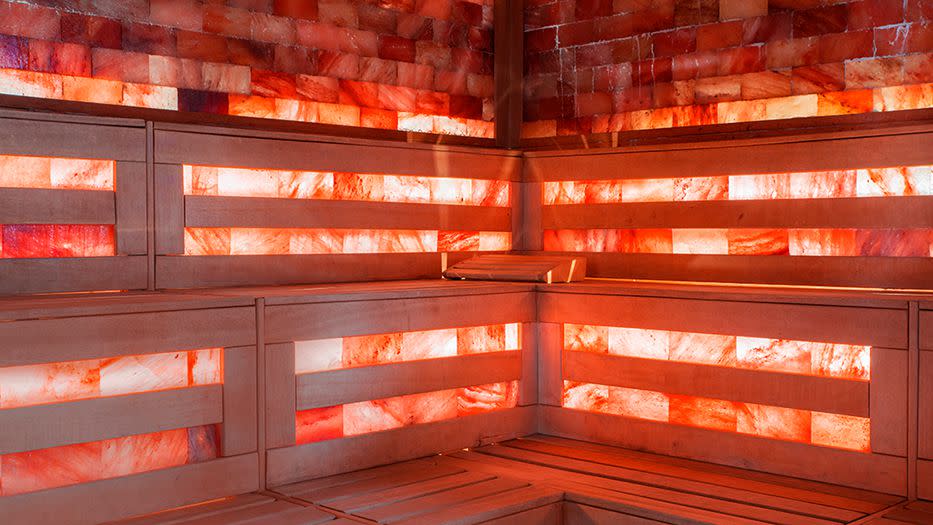Is Salt Room Therapy Really Worth the Hype?

Photo: beronb/Getty Images
You might think you have it all down pat when it comes to relieving everyday wellness issues. Headache? Pop an over-the-counter pain pill. Can't sleep? Chew a melatonin supplement. Seasonal allergies? There's a medicine for that, too. But what if you could feel better just by breathing different air — no medication required?
Halotherapy, also called salt room therapy, claims to do all that and more. The treatment essentially involves sitting in a room (often referred to as a salt cave, house, or bath) filled with rock salt and inhaling salty air that's being pumped in by a halogenerator. While the natural healing practice has a history rooted in Europe, with some of the earliest known salt caves in Poland, these salt-filled spaces are now popping up in stateside spas and yoga studios.
Salt room therapy claims to offer healing benefits such as curing the common cold, decreasing allergy symptoms, detoxifying the lymphatic systems, improving sleep, and alleviating some skin conditions. How? Unlike table salt, which is stripped of most of its natural minerals and fortified with iodine, the Himalayan rock salt you'd find in these caves is rich in minerals such as calcium, potassium, magnesium, sodium, iodine, bromine, and copper. So, in theory, you absorb these minerals when you breathe the salty air.
Additionally, being exposed to high levels of negative ions, which are found in salt, has been said to improve the severity of depression, according to a report published in BMC Psychiatry. However, the science is murky when it comes to attributing all of these health and wellness benefits to simply breathing in negative ions. And when it comes to salt room therapy, the proven benefits are mostly limited to those with lung and/or breathing issues.
Sure, the science is limited, but TBH, the mood boost that comes with trying a new wellness experience was benefit enough for me to try salt room therapy. So, to see if there was merit to all of the hyped-up claims — and hopefully, leave feeling refreshed, breathing deeper, with my skin glowing and energy recharged — I headed to Salt Cave Santa Barbara in California, which boasts 45 tons of pure Himalayan salt covering the walls, ceilings, and floors.
The first thing I noticed when I walked in was that salt caves are really pretty. So pretty you might be tempted to disrupt everyone relaxing in there with a flash-on photo. (I resisted.) The ground was made up of loose Himalayan salt rocks, the surrounding walls were stacked with Himalayan salt bricks, and salt lamps of varying sizes were tucked into corners and crevices to create an orange glow as the heat from their bulbs encouraged salt microparticles to release into the air.
The typical salt room therapy experience is customizable in the sense that when you enter, you are free to roam the space freely, sitting, standing, and meditating as you wish. At Salt Cave Santa Barbara, zero-gravity chairs are set up in a large semicircle allowing you to truly sit back and relax. I decided to bury my feet in the salt-like sand at the beach and simply enjoy the beauty of the salt bricks. I was definitely enjoying the blissful silence — it was a calming, contemplative experience. Blankets were available, but on the 90-degree day that I was there, being in the cool cave felt healing in itself.
To take my salt room therapy exploration up a notch, I was offered a private massage in a separate space, which incorporated all of the amenities available in the main room — salt floor, orange glow from salt lamps, and pretty salt bricks — and I gladly hopped up on the table for a 60-minute deep tissue massage. Altogether, I would say I was in the cave, inhaling the negative ions of Himalayan salt, for almost two hours. (See: How to Mimic a Lymphatic Drainage Massage at Home)
When I left, I felt similar to how I do after a yoga class — a sort of dazed peacefulness. I also noticed that, with it being the day after Thanksgiving and me feeling bloated and drowsy when I first arrived, I now felt lighter on my feet and more awake. The next day, I zipped up the mountain for my morning hike quicker than usual. My breathing felt more natural, and my skin felt squeaky clean and ready to sweat.
Now, was this extra pep in my step a coincidence? I mean, self care after the holidays is sure to make you feel rejuvenated, so it could be that I just needed a nice massage and an energizing hike in the fresh air. But the addition of the salt exposure definitely didn't hurt — and could be the reason I could breathe more easily and felt more energized. All in all, I'm intrigued enough to try salt room therapy again, because adding salt to the typical pampering tricks seemed to give me the extra boost of relaxation and revitalization I needed.

